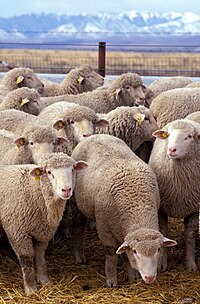
Photo from wikipedia
Background and Aim: Ectoparasitic entomoses cause serious economic losses to small-scale farmers. Parasites have both direct and indirect impacts on hosts. Domestic goats are a common target of infestation with… Click to show full abstract
Background and Aim: Ectoparasitic entomoses cause serious economic losses to small-scale farmers. Parasites have both direct and indirect impacts on hosts. Domestic goats are a common target of infestation with ectoparasitic insects. This study aimed to identify the species of ectoparasitic insects in domestic goats in Bulgaria. Materials and Methods: The study was performed in 34 farms from 29 settlements in 16 regions of Bulgaria. A total of 4599 goats from eight breeds, naturally infested with ectoparasitic insects were included in the study. The goats were inspected with a magnifying glass for the presence of skin changes (alopecia, dandruff, crusts, and nodules), eggs and adult ectoparasites. The detected insects were collected individually with tweezers and preserved in containers with 70% ethanol. Over the study period, 5,651 insects were collected; their species, sex, and developmental stage were identified by their morphological features and biometric measurements. Results: Six species from 5 genera were detected: Linognathus stenopsis Burmeister, 1838; Linognathus africanus Kellog and Paine, 1911; Bovicola caprae Gurlt, 1843; Pulex irritans Linnaeus, 1758; Hippobosca equina Linnaeus, 1758; and Lipoptena cervi Linnaeus, 1758. Linognathus stenopsis were the most prevalent, followed by B. caprae and P. irritans. In detected lice populations, female insects were more numerous; female: male ratios ranged from 2.2 to 7.2 and imagines prevailed over the nymphs. In fleas, male imagines were more numerous than females (1:0.8). Conclusion: The study demonstrated that the species L. stenopsis, L. africanus, B. caprae, and P. irritans were encountered in more than 40% of surveyed farms, situated in 68.75% of regions in Bulgaria. The most intense infestation was by species from the Linognathus genus (907 insects), whereas the highest extensity of infestation was registered for P. irritans (32.3%). This study detected P. irritans as the only flea species.
Journal Title: Veterinary World
Year Published: 2023
Link to full text (if available)
Share on Social Media: Sign Up to like & get
recommendations!